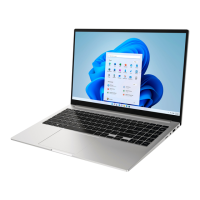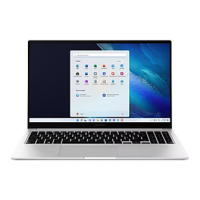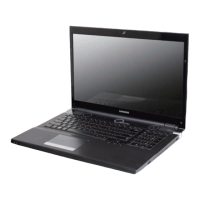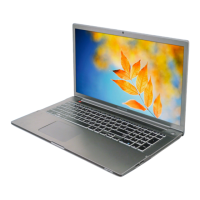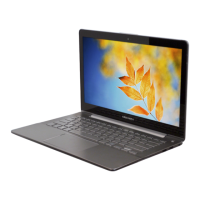Do you have a question about the Samsung NP750QUB-K01US and is the answer not in the manual?
Details the computer's functions and features, and provides usage guidelines and disclaimers.
Explains icons used in the manual for warnings, cautions, and notes.
Covers copyright ownership and restrictions on manual reproduction and distribution.
Lists trademarks of Samsung, Intel, Microsoft, HDMI, and Bluetooth.
Warns about potential data loss and advises on backup procedures.
Details support policies for factory OS and unsupported OS installations.
Explains the difference between manufacturer and Windows calculations for storage device capacity.
Explains why reported memory capacity in Windows may be less than the actual capacity.
Guides on how to convert the laptop into tablet mode by folding the display.
Describes basic touch gestures like tapping, double-tapping, and tapping and holding.
Explains how to drag items and zoom using pinch gestures on the touch screen.
Details how to scroll up, down, left, or right by swiping on the touch screen.
Explains how to use the on-screen keyboard for text input and changing layouts.
Describes how to add and switch between different keyboard language layouts.
Explains keyboard functions and how to use hot keys with the Fn key or Fn Lock.
Details the specific functions assigned to F1-F12 keys, including Samsung Settings and Wi-Fi control.
Covers basic touchpad operations like clicking, double-clicking, and moving the cursor.
Explains gesture functions such as swiping and pinching for navigation and zooming.
Guides on how to customize touchpad gestures through system settings for efficiency.
Describes how to lock and unlock the touchpad using a keyboard shortcut.
Details the process of registering fingerprints for screen unlocking via Windows Hello.
Explains how to remove registered fingerprints from the system's sign-in options.
Describes how to unlock the computer by placing a registered finger on the sensor.
Guides on connecting the computer to an external monitor using HDMI or USB-C cables.
Explains how to connect the computer to a wireless network and the internet.
Provides general information about using Samsung and third-party applications.
Details how to configure various system settings using the integrated Samsung Settings application.
Explains how to use privacy folders, secret screens, and block recording for enhanced security.
Guides on installing and updating Samsung applications and drivers for optimal performance.
Describes how to access Samsung's online customer service for troubleshooting and assistance.
Explains how to use the PC Help app for accessing support content and troubleshooting guides.
Details how to use PC Cleaner to check apps, services, and disk usage, and maintain system performance.
Explains how to adjust screen brightness using the keyboard or taskbar for eye comfort and power saving.
Guides on selecting optimal screen settings based on activity, such as Auto, Dynamic, Standard, Photo Editing, and Reading.
Details how to adjust system volume, including muting, using keyboard hot keys or the taskbar.
Provides instructions on how to access the BIOS setup screen by pressing the F2 key during startup.
Explains the layout and navigation of the Samsung BIOS Configuration screen.
Details how to set, change, or remove Supervisor, User, and HDD passwords for system security.
Guides on how to remove existing BIOS passwords by entering the current password.
Explains how to change the boot device order from the BIOS setup menu.
Describes how to calibrate the battery for accurate charge display and improved battery life.
Covers battery charging procedures, status indicators, and power saving modes.
Guides on restoring the computer to factory defaults, backing up data, and recovering from backups.
Details how to reinstall Windows using the built-in recovery function if Samsung Recovery is not supported.
Provides answers to common questions related to computer problems and solutions.
Guides on how to boot the computer in DOS mode using a USB device.
Explains discrepancies in storage capacity reporting between Windows and manufacturer specifications.
Lists technical specifications including operating environment, AC/DC rating, and PC rating.
Provides guidelines for proper posture and setup to prevent physical injury during computer use.
Advises on optimal screen positioning and brightness for eye comfort and health.
Offers advice on safe listening levels and using audio devices to prevent hearing damage.
Outlines recommended operating conditions and cautions for safe use, including breaks and lighting.
Details how to charge the battery using AC power, including airplane usage and proper plug connection.
Covers essential safety instructions for handling the power cord, adapters, and general computer usage.
Explains laser safety standards for CD/DVD drives and precautions to avoid radiation exposure.
Lists general requirements for power cord sets applicable to all countries for safe operation.
Provides an overview of wireless device usage considerations and restrictions.
Details specific safety requirements and notices for wireless devices in the USA and Canada.
Explains FCC Part 15 compliance for unintentional radio frequency emitters and interference.
Details FCC Part 15 compliance for intentional radio frequency emitters and usage restrictions.
Covers RF signal exposure limits and certification information based on FCC guidelines.
Explains the WEEE symbol and proper disposal methods for electronic waste.
Provides specific information for safe disposal and recycling within India.
| OS | windows 10 home |
|---|---|
| Software | samsung recovery solution, mcafee livesafe (60 days trial), samsung settings, samsung gallery, studio plus, teampl, samsung link sharing, live message and samsung flow |
| Touch Screen | yes |
| Screen Size | 15.6 inches |
| Screen Resolution | 1920 x 1080 (full hd) |
| Processor Brand | amd |
| Processor Model Number | 3500u |
| Storage Type | ssd |
| Storage Capacity | 256 gigabytes |
| SSD Capacity | 256 gigabytes |
| Type of Memory | ddr4 sdram |
| System Memory | 8 gigabytes |
| Speakers Type | stereo speakers |
| Backlit Keyboard | yes |
| Security | fingerprint reader |
| Headphones Output | yes |
| Battery Type | lithium-ion |
| Depth | 9.7 inches |
|---|---|
| Height | 0.7 inches |
| Width | 14.2 inches |
